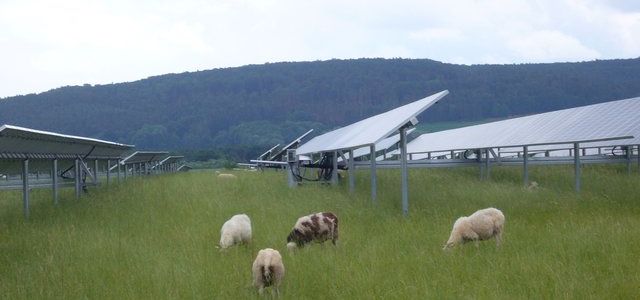A new study finds that Germany has physical space for roughly 50 percent more onshore wind capacity than the country would need for 100 percent green electricity – and the official target is only 80 percent. Craig Morris takes a look.

Sheep grazing below a ground-mounted solar array in Bavaria: people who say solar arrays and wind farms take up space should remember dual usage. (Photo by Craig Morris)
One of the most frequent critiques of the Energiewende, especially among proponents of nuclear, is that relatively densely populated countries like Germany simply lack the space needed for renewables to cover a large share of energy supply. Now, a whopping 226-page study (PDF in German) has been published by the German Institute for Building, Urban Affairs and Spatial Development (BBR, a governmental organization subordinate to the Environmental Ministry). It finds that Germany could install 125 gigawatts of wind turbines on only 1.7 percent of the country – on land, not including offshore wind farms. Likewise, 143 gigawatts of PV could be installed on 0.9 percent of the country.
To put these numbers into perspective, a recent study by Fraunhofer IWES investigating a 100 percent renewable supply of electricity found the need for only 87 gigawatts of onshore wind along with 40 gigawatts offshore. For PV, IWES estimated that 134 gigawatts would be needed, slightly less than what the BBR found to be feasible.
Is 0.9 percent of the country for PV a lot? One thing is often overlooked: put solar on a rooftop, and you haven’t taken up any additional space at all. The study found that “even if a third of all suitable roofs are not used for solar because the building owners simply don’t want to, the technically suitable roof potential is enough to install 65 GW by 2032… without any need for new ground-mounted arrays at all.” In other words, Germany could get around 10 percent of its electricity from PV using only two thirds of suitable existing rooftops.
The assessment was based on the two categories of “taboo zones “and “suitable zones,” as defined by the German Environmental Agency (UBA). In other words, the evaluation of feasibility took account of areas where renewable energy installations are completely ruled out, say, for conservation reasons.
It should also be noted that this study is hardly the first of its kind. For instance, in 2012 alone, a “Potential Atlas for Renewable Energy” was published for the German state of North Rhine-Westphalia (PDF in German), one for Brandenburg (PDF in German), and another for Baden-Württemberg (PDF in German). Other studies (I’ll spare you the links – they are listed in the BBR report) have also focused on such issues as noise, biodiversity, and impacts on other land usage. The important thing to keep in mind here is that the goals of Germany’s 16 states “collectively exceed by far the federal government’s targets,” at least up to 2022. German states are investigating their own potential and finding that they can do even more.
How much land are we talking about? 52 percent of the country is currently used for farming, followed by 30 percent forest. Settled areas and roads take up 13 percent; rivers and lakes, 2.4 percent. Other areas (a category that includes Germany’s tremendous coalfields) make up 1.7 percent of the country (source in German). And since Germany won’t need those coalfields anymore, we could subtract them from the equation. In other words, the space that Germany would need to reach its targets for wind and solar are close to what the country now lists under “other.”
By the way, if you’re wondering about bioenergy, the study puts the potential within the power sector at around 52 TWh annually – hardly more than the 42.8 TWh of electricity generated from biomass last year. As I explained previously, the growth of biomass is over in Germany.
In a nutshell, Germany can reach its target of 80 percent renewable electricity without a major impact on the landscape; the IWES study even found that the number of wind turbines needed would be lower than the number installed today because future turbines would be so much more powerful. The Germans will also reach this goal without a lot more biomass use. And by the way, livestock will graze and crops will grow in-between those wind turbines. It’s further good news for the Germans and the climate – and bad news for proponents of nuclear who keep banging the energy density drum.
Craig Morris (@PPchef) is the lead author of German Energy Transition. He directs Petite Planète and writes every workday for Renewables International.
[…] be much smaller than, say, a comparable solar farm of the same output.” Solar on rooftops takes up no space, and we simply do have space for ground-mounted solar in many […]
[…] PwC’s limit. For instance, an investigation in Germany found that the Germans could get around 10% of their electricity from solar arrays on only two thirds of suitable existing […]